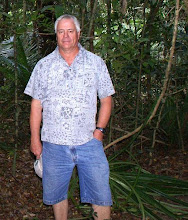
 Today, I finally had a chance to get a close look at our brand new crossing complex, made up of a 6-bay photoperiod facility (PF)(Pic 1); a 3-compartment crossing facility (XF) (Pic 2); 12 mobile crossing carts of which four can be rolled from the PF into the XF; and finally an isolation pad (Pic 3). I was excited, in part, because I had a lot to do
Today, I finally had a chance to get a close look at our brand new crossing complex, made up of a 6-bay photoperiod facility (PF)(Pic 1); a 3-compartment crossing facility (XF) (Pic 2); 12 mobile crossing carts of which four can be rolled from the PF into the XF; and finally an isolation pad (Pic 3). I was excited, in part, because I had a lot to do  with its design. The concept behind the crossing facility is novel in the sense that it does not follow the model of any other sugarcane crossing facility in the world that I am aware of. To see something that you and your associates draft on paper actually come to fruition and exceed your expectations is very exciting indeed. There are bugs to be worked out, but all in all, I couldn't have been more pleased with the outcome.
with its design. The concept behind the crossing facility is novel in the sense that it does not follow the model of any other sugarcane crossing facility in the world that I am aware of. To see something that you and your associates draft on paper actually come to fruition and exceed your expectations is very exciting indeed. There are bugs to be worked out, but all in all, I couldn't have been more pleased with the outcome.Tomorr
 ow, Argus will be showing us how to use all of the controls. The 3-compartment XF has 1) a room for rolling in two-sets of carts (= 4 carts) with sugarcane plants on them, 2) a crossing room where crosses are arranged and fertilization occurs in one of 99 isolation cubicles (Pic 4), and 3) a maturation room where tassels are maintained while being somewhat isolated from one another until the seed fully matures and can eventually be harvested from the tassel (Pic 5).
ow, Argus will be showing us how to use all of the controls. The 3-compartment XF has 1) a room for rolling in two-sets of carts (= 4 carts) with sugarcane plants on them, 2) a crossing room where crosses are arranged and fertilization occurs in one of 99 isolation cubicles (Pic 4), and 3) a maturation room where tassels are maintained while being somewhat isolated from one another until the seed fully matures and can eventually be harvested from the tassel (Pic 5).In th
 e past, our seed production has varied greatly from year to year, ranging from roughly 100,000 to 1,000,000 seeds. With the much greater temperature control, we should be able to maintain optimum conditions for pollen production. I anticipate much better seed production from now on, and will be disappointed if we cannot consistently produce at least 1,000,000 viable seeds per year from now on.
e past, our seed production has varied greatly from year to year, ranging from roughly 100,000 to 1,000,000 seeds. With the much greater temperature control, we should be able to maintain optimum conditions for pollen production. I anticipate much better seed production from now on, and will be disappointed if we cannot consistently produce at least 1,000,000 viable seeds per year from now on.By the way, if you look at the greenhouse (XF), you will notice the super-structure that supports it. It was designed to withstand the wind force of a Cat 4 hurricane, as I understand.

No comments:
Post a Comment